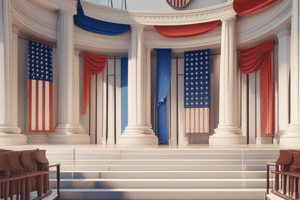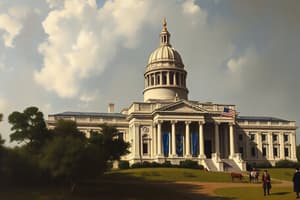Podcast
Questions and Answers
What is the primary purpose of the Bill of Rights?
What is the primary purpose of the Bill of Rights?
- To establish the electoral process
- To protect individual liberties (correct)
- To define the structure of the government
- To regulate interstate commerce
Which amendment protects against unreasonable searches and seizures?
Which amendment protects against unreasonable searches and seizures?
- 6th Amendment
- 2nd Amendment
- 8th Amendment
- 4th Amendment (correct)
In which case was the principle of judicial review established?
In which case was the principle of judicial review established?
- Marbury v. Madison (correct)
- Roe v. Wade
- Plessy v. Ferguson
- Brown v. Board of Education
What does the separation of powers aim to prevent?
What does the separation of powers aim to prevent?
Which of the following best describes federalism?
Which of the following best describes federalism?
When was the U.S. Constitution officially ratified?
When was the U.S. Constitution officially ratified?
Which amendment protects citizens' rights in criminal cases?
Which amendment protects citizens' rights in criminal cases?
Which branch of government is responsible for making laws?
Which branch of government is responsible for making laws?
What does the 8th Amendment prohibit?
What does the 8th Amendment prohibit?
What is one of the key functions of the judicial branch?
What is one of the key functions of the judicial branch?
Flashcards are hidden until you start studying
Study Notes
Constitution Study Notes
Bill of Rights
- First ten amendments to the U.S. Constitution.
- Ratified in 1791 to protect individual liberties.
- Key rights include:
- Freedom of speech, religion, and the press (1st Amendment).
- Right to bear arms (2nd Amendment).
- Protection against unreasonable searches and seizures (4th Amendment).
- Rights of accused persons in criminal cases (5th-6th Amendments).
- Protection against cruel and unusual punishment (8th Amendment).
Separation of Powers
- Division of government responsibilities into three branches:
- Legislative: Makes laws (Congress - House of Representatives and Senate).
- Executive: Enforces laws (President and administration).
- Judicial: Interprets laws (Supreme Court and lower courts).
- Established to prevent any one branch from gaining too much power.
Judicial Review
- The power of courts to assess whether a law is in compliance with the Constitution.
- Established in the landmark case Marbury v. Madison (1803).
- Ensures that legislative and executive actions are subject to review and can be invalidated if deemed unconstitutional.
Federalism
- System of government where power is divided between a central authority and individual states.
- Allows states to have their own laws and regulations while adhering to federal laws.
- Promotes a balance of power, ensuring that both national and state governments can operate effectively.
When was the Constitution created
- Drafted in 1787 at the Constitutional Convention in Philadelphia.
- Ratified by the states in 1788.
- Officially took effect on March 4, 1789.
Bill of Rights
- Comprises the first ten amendments to the U.S. Constitution, ratified in 1791.
- Protects individual liberties essential for democracy and personal freedom.
- Key rights include:
- 1st Amendment: Guarantees freedom of speech, religion, and press.
- 2nd Amendment: Affirms the right to bear arms.
- 4th Amendment: Offers protection against unreasonable searches and seizures.
- 5th-6th Amendments: Safeguard the rights of accused persons in criminal proceedings, including due process and the right to a fair trial.
- 8th Amendment: Prohibits cruel and unusual punishment.
Separation of Powers
- Establishes three branches of government with distinct responsibilities:
- Legislative Branch: Responsible for making laws; consists of Congress, which is divided into the House of Representatives and the Senate.
- Executive Branch: Responsible for enforcing laws; led by the President and includes the administration.
- Judicial Branch: Responsible for interpreting laws; includes the Supreme Court and lower federal courts.
- Designed to prevent concentration of power in any single branch, promoting a system of checks and balances.
Judicial Review
- Grants courts the authority to evaluate the constitutionality of laws and government actions.
- Established by the landmark case Marbury v. Madison in 1803, reinforcing the judiciary's role.
- Ensures that actions by the legislative and executive branches can be deemed unconstitutional and invalidated.
Federalism
- A system where governmental power is shared between a central authority and individual states.
- Empowers states to create their own laws and regulations, fostering local governance while complying with federal laws.
- Promotes a balance of power, ensuring effectiveness and responsiveness at both national and state levels.
Creation of the Constitution
- Drafted in 1787 at the Constitutional Convention held in Philadelphia.
- Ratified by the states, becoming effective on March 4, 1789, following a year of state approvals.
- Serves as the supreme legal document that governs the United States and outlines the structure of the government.
Studying That Suits You
Use AI to generate personalized quizzes and flashcards to suit your learning preferences.



